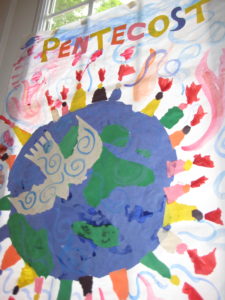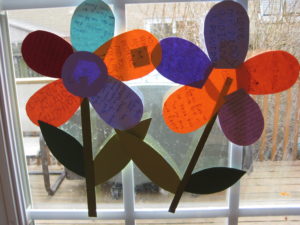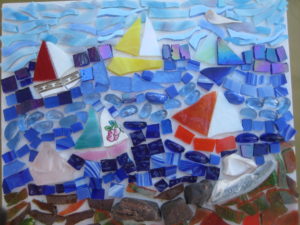After the Party
 After every big celebration comes the crash. Party guests go home and we collapse on the couch with a headache. The special dinner that took days to plan and prepare is devoured in an hour, leaving only a kitchen full of dirty dishes. The warmth of Christmas holidays seeps away too quickly, and January feels impossibly bleak and cold. So it seems with Pentecost, that exuberant culmination of the colourful journey from Advent to Eastertide. After the birthday cake is eaten, the candles extinguished, and all those red and orange balloons deflated, what is there to look forward to but that monotonous path of green we call Ordinary Time?
After every big celebration comes the crash. Party guests go home and we collapse on the couch with a headache. The special dinner that took days to plan and prepare is devoured in an hour, leaving only a kitchen full of dirty dishes. The warmth of Christmas holidays seeps away too quickly, and January feels impossibly bleak and cold. So it seems with Pentecost, that exuberant culmination of the colourful journey from Advent to Eastertide. After the birthday cake is eaten, the candles extinguished, and all those red and orange balloons deflated, what is there to look forward to but that monotonous path of green we call Ordinary Time?
But perhaps this is not fair to Pentecost. Maybe this special day is not simply an ending—the climax of coming to know Jesus in varied ways. It is also a beginning—the launching point from which his followers are scattered into the world like seeds, or sparks from a bonfire. Looking at Pentecost this way emphasizes connection: connection between the story of Jesus and how we embody it in our own place and time.
Earth, Wind, and Fire: Creating With Pentecost Imagery
 Art offers many possibilities for exploring the imagery of wind and fire. Try making some old fashioned toys that depend on the breeze to move them: pinwheels, origami boats, walnut shell ships with paper sails, mobiles. Notice how their movement is evidence of the wind at work. Read John 3:8 and ask: Where do we see the Spirit at work? In us? Around us?
Art offers many possibilities for exploring the imagery of wind and fire. Try making some old fashioned toys that depend on the breeze to move them: pinwheels, origami boats, walnut shell ships with paper sails, mobiles. Notice how their movement is evidence of the wind at work. Read John 3:8 and ask: Where do we see the Spirit at work? In us? Around us?
Playing with fire is tricky, but you could make candles by rolling sheets of beeswax, or cutting shapes out of wax sheets and pressing them onto pre-made candles. Sitting around a backyard bonfire or small brazier can be a time to wonder aloud about the power of fire both to create and destroy: What things need to be made new? What needs to be destroyed?
As the Spirit connects the many into one, so do some creative projects: torn paper collages, mosaics made of glass pieces, beads, tiles, or small stones. Wonder together about how the Spirit uses small things—even broken things—to create something beautiful.
 Other images to explore through art are the fruits of the Spirit. Begin by reading Galatians 5:22-23, then make prayer beads: participants can choose pre-made beads that represent each fruit, or make their own with polymer clay. Completed beads can be used for prayer: as you hold each bead, think about the quality it represents and ask the Spirit to help you show it.
Other images to explore through art are the fruits of the Spirit. Begin by reading Galatians 5:22-23, then make prayer beads: participants can choose pre-made beads that represent each fruit, or make their own with polymer clay. Completed beads can be used for prayer: as you hold each bead, think about the quality it represents and ask the Spirit to help you show it.
Follow Your Breath: Prayer and Mindfulness
This year many of us have become more aware of our breath. Wearing masks has heightened our appreciation for the simple pleasure of a deep inhale. Playing with the etymological connection between breath and spirit, we can explore new ways of working with our breath, both to relieve stress and anxiety, and to deepen our gratitude for this life force that animates us.
Try this simple outdoor variation on lectio divina: sit quietly and use your senses to detect the wind—what it sounds like, how it feels, where you see it moving. What do you notice? Does this remind you of anything the Spirit may be doing in your own life?
 On a day when there are puffy clouds, lie on your back and imagine it is your breath making the clouds move. Or create a simple breath prayer. Choose different words for the inhale and exhale (e.g. I breathe in calm; I breathe out fear). You can also use the exhale to breathe out love in ever-widening circles (i.e. I breathe out love to myself…my family…my friends…my neighbours…all beings, etc.)
On a day when there are puffy clouds, lie on your back and imagine it is your breath making the clouds move. Or create a simple breath prayer. Choose different words for the inhale and exhale (e.g. I breathe in calm; I breathe out fear). You can also use the exhale to breathe out love in ever-widening circles (i.e. I breathe out love to myself…my family…my friends…my neighbours…all beings, etc.)
Prayer flags are meditative to make and send a positive message to your community. Decorate strings of fabric flags with words or symbols that represent your hopes for the world: peace, love, joy, truth, health. As they flutter, picture your prayers carried on the wind. Or blow bubbles and imagine each one is a prayer borne on the breath of the wind.
Air currents are the way some animals travel and seeds are spread. Build on this connection by making simple feeders for birds or butterflies, planting a pollinator garden, or painting garden stones. While you create, talk about the many ways we are connected to the natural world.
Sparks and Seeds: Reaching out when we can’t go out
The connection between ourselves and Jesus is most clearly seen in acts of love and kindness. When my children and I were in quarantine before Christmas, we were blessed with gifts of food: meatloaf dropped off on the porch, surprise pizza delivery. When caring for one another demands keeping our distance, we have had to find other ways to reach out.
How about a virtual cooking class with a youth group? A leader can demonstrate how to make a casserole, while everyone follows along at home. The casseroles can then be frozen and distributed to anyone who needs a meal. Old-fashioned letter writing and card making are an ideal way of connecting with others. Cards and letters can be delivered to residents of long-term care facilities, teachers or other school staff, medical workers, or shut-ins in your own community. For a bit of inspiration check out the picture book What Grew in Larry’s Garden by Laura Alary and Kass Reich (Kids Can Press, 2020).
We Are All Connected
 The stories we tell and how we tell them shape who we are and the kind of world we help create. Pentecost celebrates the Spirit that connects us all—to one another, to Christ, to other living things, to the fragile and beautiful planet we share. This special day, and the lively season of germination and growth that follows, is a rich opportunity to explore and deepen that connection.
The stories we tell and how we tell them shape who we are and the kind of world we help create. Pentecost celebrates the Spirit that connects us all—to one another, to Christ, to other living things, to the fragile and beautiful planet we share. This special day, and the lively season of germination and growth that follows, is a rich opportunity to explore and deepen that connection.

